
“Always fond of the marvelous”
The hidden history of Anna Adolph
What I discovered about this forgotten outsider artist taught me much about the Anglo-American West. This article is a continuation of my survey of 19th century utopian novels by women but can be read on its own.
Arqtiq (1899), credited to “Mrs. Anna Adolph”, concerns a narrator, also named Anna, who builds an airship to fly her family and friends to the North Pole. They discover that the earth is hollow and glows with the light of a holy aurora, and there encounter a race of friendly telepathic giants, go scuba-diving with mermaids, and interrogate a wizard about God. The climactic scene is a long hallucinatory flight through the earth’s core to where they meet tiny moon people, a reanimated Abraham Lincoln, and an omnipotent deity of both genders.
Many early utopian novels are pretty bananas, but it’s the writing style that makes Arqtiq truly unique. The prose feels modernist—staccato, ungrammatical, weirdly punctuated—but with a hypnotic rhythm that lends the whole work a kind of dreamlike intelligibility:
I wander around by myself to soon get lost in the tangle of halls, which labyrinth every way. Just here are niches in the walls with statues of people and animals like life. Here is a family group. The host is deep in Arc news ball (writing rolled up) his wife is crossing the floor toward the grandma, asleep in her arm chair, a kitten rolled up beside it.
Adolph’s dialog is especially striking. It’s often inflected only by adverbs and reaction asides, as if the verbs and speech tags had been raptured away. The efficiency of it kind of grew on me:
“You will be the Mascot, Mae Searles. But I do not think you will go very far,” dubiously.
“You will change your mind, mamma, when I bring you home a little bear,” makes us laugh.
The self-published final product is so filled with typos and sentence fragments that it’s hard to distinguish stylistic affectation from printing error. Quite a few people who’ve read it have wondered whether the author was a native speaker. At times it reads like the output of a neural net—it resembles the contours of human prose, but is thoroughly alien.
Scholars typically mention Arqtiq only in passing, as just one of many kooky hollow earth novels notable mostly for being written by a woman. Not a single one gave any biographical detail about Mrs. Anna Adolph at all, and I really wanted to know who wrote this strange little book.
I did not know where she lived, when she died, her age when she wrote it, or if “Anna Adolph” was a pseudonym. So I started digging—through my local library, Google Books, the Internet Archive, newspaper archives, census records, eBay, the Library of Congress, and gravesite archives. I would come upon a lead—a variant spelling! a new address! — and start all over again, one search cascading into dozens or hundreds. What started out as a casual way to pad out a post on some interesting old books turned into weeks of obsessive genealogical research.
As far as I know, this is the only history of this author to have been written.
“We are bound to the North Pole”
Marion, New York (1841-1875)
Mrs. Anna Adolph was born in on February 19, 1841 as Ann Elizabeth Eddy, in Wayne County, New York, not far from Rochester. Her parents were Alden Huggins Eddy and Anne Hickey. The Eddys were old New England Pilgrims, having arrived in Plymouth, Massachusetts from Cornwall in 1620. By her youth in the mid-1800s, the family was an undistinguished group of small landholders and local merchants. Anna lived at home with her parents and two brothers into her early teens.
In the summer of 1850 the California Gold Rush was in earnest, and father Alden Eddy meant to seek out his fortune. He booked passage on the steamship S.S. Oregon with 317 other passengers (all but six were men) on a voyage from New York City to Panama to San Francisco over 55 days.
“Mining born and golden reared”
Nevada City, California (1875—c.1900)
This Nevada City was a curious sight, not easily described. On account of the gold fever, all business dealings were conducted on a fraudulent basis. The streets swarmed with horse and gold thieves, traders and speculators, gamblers and rascals.
—German miner Herman Scharmann’s personal account, circa 1850
Nevada City, 60 miles east of Sacramento, is nestled in the foothills of the Sierra Nevada mountains and was a central hub for mining activity in the mid 1800s. Alden brought out his two sons, leaving his wife and daughter back in New York, and settled here.
In his census form at the time he listed his occupation as “California miner.” That was disingenuous. Eddy and his brother, William Matson Eddy, were part owners of the Nevada Water Company, a New York corporation that diverted water from the Yuba river to supply French Corral and other mining camps near Sacramento. The water was fuel for the technique known as hydraulic mining, in which massive high-pressure water hoses were used to blast apart gold-rich cliffs.
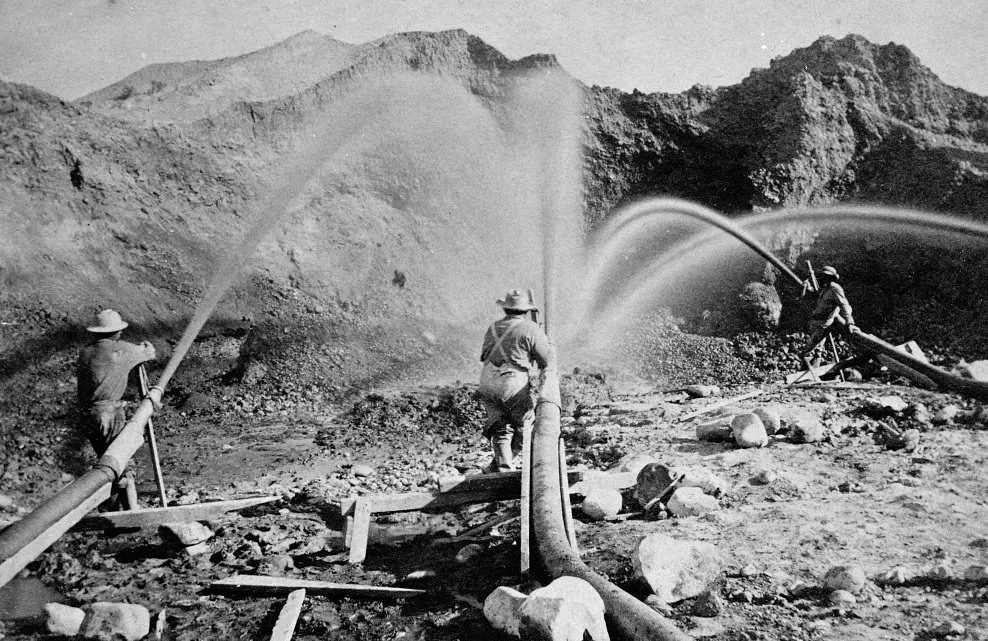
Hydraulic mining was environmentally devastating even by the laissez-faire standards of the 19th century. “The bed of the creek which had once flowed past the town was now choked up with heaps of trailings—the washed dirt from which the gold has been extracted,” wrote one contemporary observer. These congested rivers were subject to constant flooding and valuable farmland was buried in silt. The hydraulic mining industry promised to self-regulate, but investigators recount hidden sluices that illegally drained into rivers and hired guns who threatened regulators at the end of a barrel. The practice was finally banned by legal decree in 1884.
Alden Eddy was never implicated in these tactics; he was undoubtedly corrupt but his tastes ran to embezzlement. The Nevada Water Company conducted its business “rather loosely”. Three of the shareholders conspired to divert 95% of the corporation’s profits to themselves, with Alden taking more than $20,000 ($166,000 today) to buy his own mining claims. A preliminary court ruling threw all three of them off the board, but the New York State Supreme Court overturned it, and the case fizzled out.
Alden Eddy quietly sold his company shares to his brother William Matson Eddy in 1867, but still held claims to mines that he’d already bought with the $20,000. These were finally stripped from him on sheriff’s orders in 1876, and sold to the highest bidder. Alden would live another 20 years, but his mining career was over.
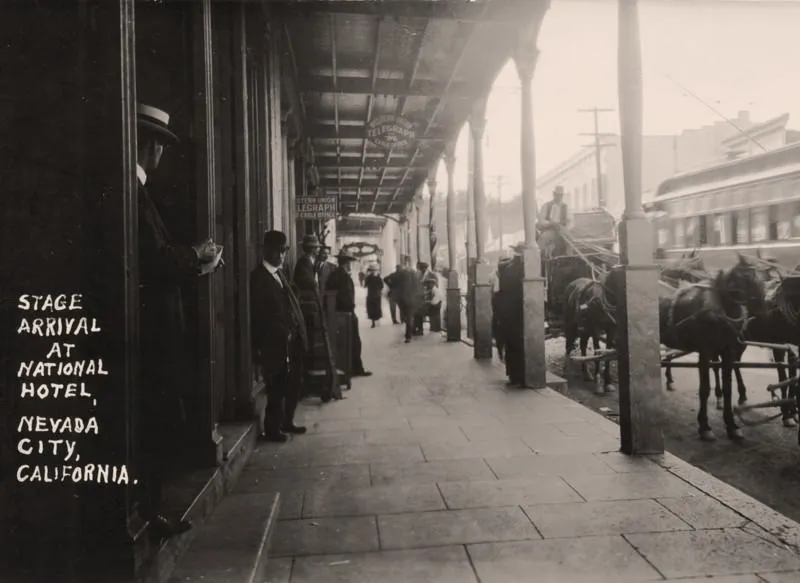
By the 1870s the era of easy mining had ended, so Alden used the cash he still had to purchase the National Exchange Hotel in 1874, turning it over to his elder son Stanley to operate.
Stanley was an indifferent hotelier in lawless times. A year into his tenure, a prostitute shot a customer in Nevada City’s Chinatown; the man stumbled into the hotel and died. Bare wiring ran along ungrounded iron railings, and in 1887 a lightning storm electrocuted everyone on the balcony (none fatally). When Stanley finally sold off the hotel in 1891, the new owners sniffed that it was “dilapidated.”
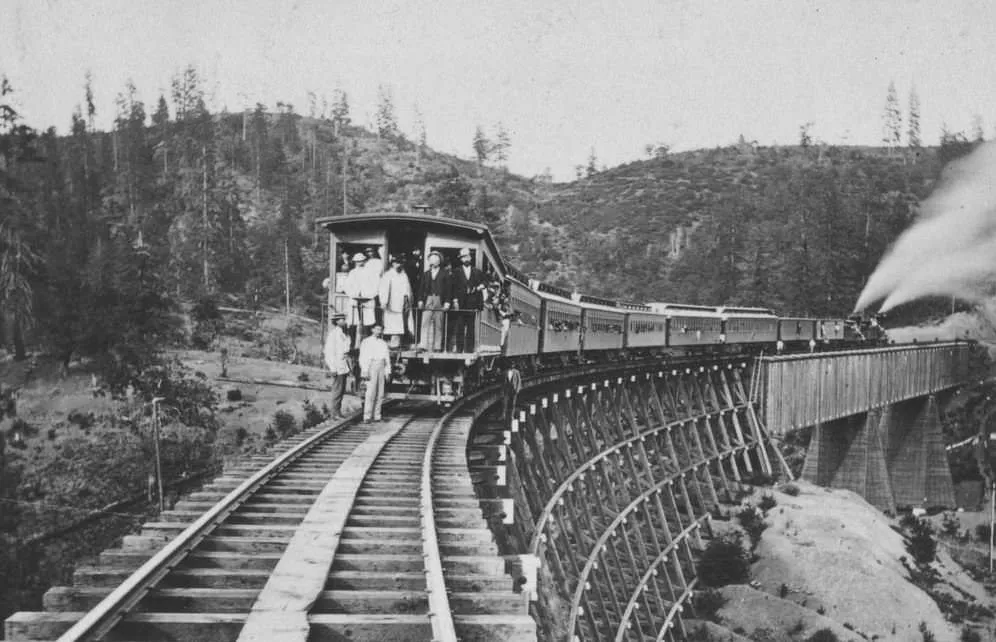
Alden Eddy and his sons returned home to New York briefly in November 1874 as by then his wife Anne Hickey had died. With her remaining family fully established in California, it made sense for the 34-year-old Anna to finally join them. Accompanied by her father, Anna arrived in San Francisco via railroad on October 18, 1875.
In the open pages of Arqtiq, Anna writes about her airship flying eastward over some mountains:
We now become aware that a train is approaching on the single track that is hanging over the grade on the canyon side. We have no choice but to unfurl our wings and rise in the air, as the engineer wildly blows his whistle. Brushing the pine tree tops, we cross over the peak and seek the track on the other side of it, selecting an opening in a thicket for that purpose.
Finding it occupied by miners digging away, we hallo, when they look every way but up, as we land in their midst as though dropped from the sky. Their consternation is depicted in set jaws, as we give military salute and roll off.
Despite the fact that she’d spent more than half her life there, her novel mentions New York only in passing. It’s clear in her writing where she felt most at home:
I look out at the country, dotted with quartz-mill chimneys, with their heavy roar, as the heavy stamp crushes the granite to free the gold imprisoned in their bastile. To all we bid good-bye, as we turn Cape Horn, and though still among the clouds, we see and hear the rushing river below.
Anna and Charles
The host, in gleesome impulse, elects to take me. Raising me on his hand, he asks my name. Charley, quite diverted, gives it, “Anna.”
Charles Adolph was born in 1844 in Wittenberg, Germany and emigrated to New York in the 1850s. In 1863 he enlisted in a voluntary Civil War unit and was discharged at the end of the war two years later. By 1879 he was in California, working at the Rough and Ready mining camp and living in a house with other European immigrants.
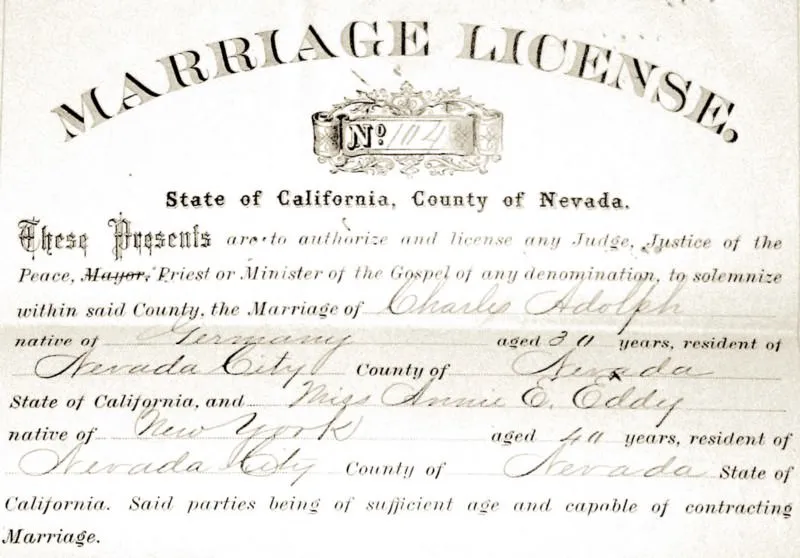
He was 30 when he married 40-year old Anna Eddy in 1881. They lived together in the tony neighborhood of Aristocracy Hill, renting one of the largest homes in town, which they shared with a young boarder named John Hussey. Charles continued to mine, sifting through the silt that washed down through mining runoff, an enterprise that returned a healthy $30 per day at first, but over time declined to $6—still double the average income at the time.
Even with one of the better homes in town, life in a Gold Rush city was challenging. Nestled in the foothills of the Sierra Nevada mountains, Nevada City is prone to harsh winter weather, and in the winter of 1890 year the town was entirely snowed in for weeks, with travel possible only by snowshoe or sled and accumulation up to 15 feet.
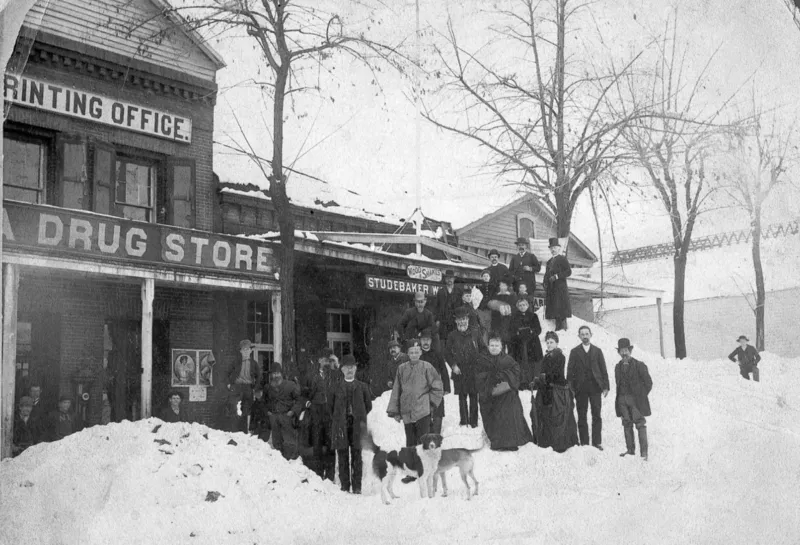
The summer of that year was no better for the Adolphs. Nevada City, barely more than a collection of wooden shacks, was plagued by fire, and in June 1890, Anna and Charles’s house burned down, a total loss for the furnishings, the entire household “barely escaping with their lives”. Hussey, their politically connected housemate, recovered well enough to marry a local socialite, decamp for Harvard, and enjoy an apparently lucrative career in producing patented canned, desiccated eggs.
Arqtiq (1899)
Saucy arriving, takes from her pocket silk and needle, deftly fashions a butterfly, which she affixes, waving to my shoulder. As I ask: “What can I do?”
“O, you can print the books you write, you know. And Charley,” laughing, “can paint.”
Arqtiq was published in 1899, “for the author,” by Carruth & Carruth, an Oakland-based printer (their motto: “Printing is Wherein We Excel”). Carruth produced local directories and recipe collections but also some longer works, including an anti-Catholic tract and the finely illustrated 1902 book, The False and the True: A Psychic Phantasmagoria of the Resurrection in Epic Verse.
Somehow Arqtiq made its way to the desk of the Sunday edition of the San Francisco Chronicle on January 27, 1901:
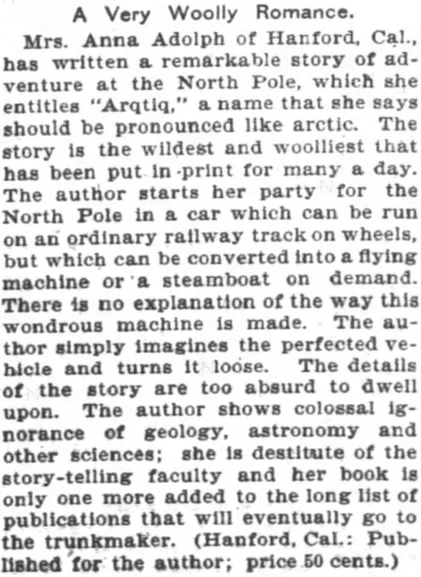
A Very Woolly Romance.
Mrs. Anna Adolph of Hanford, Cal., has written a remarkable story of adventure at the North Pole, which she entitles “Arqtiq,” a name that she says should be pronounced like arctic. The story is the wildest and wooliest that has been put in print for many a day. The author starts her party for the North Pole in a car which can be run on an ordinary railway track on wheels, but which can be converted into a flying machine or a steamboat on demand. There is no explanation of the way this wondrous machine is made. The author simply imagines the perfected vehicle and turns it loose. The details of the story are too absurd to dwell upon. The author shows colossal ignorance of geology, astronomy and other sciences; she is destitute of story-telling faculty and her book is only one more added to the long list of publications that will eventually go to the trunkmaker. (Hanford, Cal.: Published for the author; price 50 cents.)
As Arqtiq was self-published, I assume that it was Anna who mailed a copy to the Chronicle, pronunciation guide enclosed. When I first published this piece I noted that this review made me sad, assuming that Anna was hurt by the public mockery of her masterpiece. I’ve since found her wry response in the local paper:
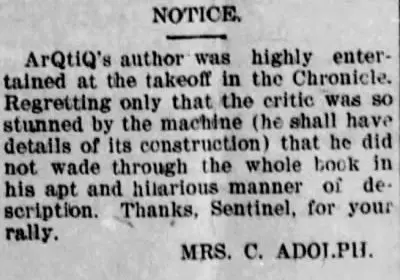
Notice.
ArQtiQ’s author was highly entertained at the takeoff in the Chronicle. Regretting only that the critic was so stunned by the machine (he shall have details of its construction) that he did not wade through the whole book in his apt and hilarious manner of your description. Thanks, Sentinel, for your rally.
Mrs. C. Adolph.
The odd capitalization would appear to be the canonical form of the title: Arqtiq’s cover and title page is all-caps and thus typographically ambiguous, but around publication time, Anna took out dozens of inscrutable ads in the local papers hyping the book:
Many UniQue ideas in ArQtIq.
ArQtiQ is already a Favorite.
Campaign Illumination! in ArQtiQ.
High Morals in ArQtiQ.
Subscriptions for Arqtiq are very lively.
ArQtiQ has come for everybody.
(The last seems like kind of a threat.)
I’ve adopted Anna’s mixed-case title in my digital version of the book, since I now believe that was her original intent.
“Silently we appear; like a shadow disappear.”
Hanford, California (1900—1917)
In November 1899, after the book was published, Anna’s 81-year-old father died in their home, of “old age and rheumatism”. She and Charles moved to join her brother Stanley in Hanford, California, deep in rural San Joachim Valley. Hanford had only recently been incorporated and was still reeling from a bloody if largely forgotten dispute between railroad agents and homesteaders. Charles listed his profession on census records as landscaper or carpenter and was an early adoptor of the vacuum cleaner. Stanley raced horses and owned a large ranch east of the city, now the site of another Eddy Street. His son William became a local police officer (newspaper accounts record the time he was bitten on the nose).
Fifteen years after the book was published, Anna, then in her mid-sixties, began to write strange letters to the San Francisco Call. Her 1905 “solution” to the mystery of sun spots suggests that Arqtiq was not so much fiction as “ha ha only serious”:
The earth is hollow, and a mild light spreads throughout the interior. Accumulations of winter ice are at the north pole, at which is an opening to the earth’s center, a necessary opening for keeping the light inside. These immense overflows of snow or ice fall down into or above said light. They melt and ascend in vapor, which being illumined below by the light gives us the aurora borealis.
She also wrote on the topics of women’s suffrage (for, I guess?) and on issuing more licenses for saloons (against, I think?). She did not like the site chosen for the Hanford Carnegie library and might be gratified to know it was shuttered in 2020 due to lack of funds. Like her novel, the letters are superficially erudite but hard to follow, as if a normal paragraph was shaken very hard and not all its words landed in exactly the right order.
But she also wrote ordinary pieces for the local Hanford papers. In 1901 she returned to her native western New York, presumably to see family, but contrived to visit the 1901 Pan-American Exposition in Buffalo along the way. Her report is laden with typos so this would appear to be pretty much raw, unedited Anna:
I have viewed again their corn shocks and piles of yellow pumpkins, their apple orchards with piles and piles of rich red apples, their autumn tinted woods, strewn with leaves of variegated hues, their pretty farm houses and well-fenced farms—every spot cultivated.
“It is gone, and we too are going out.”
Anna Elizabeth Eddy Adolph was “summoned by death” at the age of 76 “and 6 days”, a few weeks after a severe stroke:
During her illness she has been cared for her by her husband, Chas. Adolph. Sunday morning while he was preparing her breakfast, Mrs. Adolph asked for a drink of water. Mr. Adolph brought her the water and went about his morning’s work. Returning in a few minutes to her bedside, he found that life had departed, evidently peacefully and without a struggle.
She is buried in Hanford Cemetery with Charles. He outlived her, being 10 years her junior, and died in a veteran’s hospital in Los Angeles County. The $7.30 he had on him was mailed to Dell Eddy, his niece.
Though she had no children, her brother Stanley did, and his son William did, as did his children and their children. I found her great-great-great nephew on Twitter. He likes basketball, and he seems nice.
The Adolphs’ addresses in the 1900 and 1910 censuses no longer exist and are now empty farmland, occupied only by a walnut dehydration facility.
“It was a grand inspiration. I will write it all down.”
Arqtiq is not a good book, but this research has made it, for me, into a kind of story of Oz: a patchwork of fact and fiction and a long winding road to an uncertain conclusion. Unlike most other utopian stories, the protagonist brings an extended family with her on the trip into the unknown. The characters of Anna, Charley, Mae, and Father were all real people, whose lives were alternately eccentric, brave, mundane, or felonious.
Where Anna lived the ground was in continual upheaval, with scars that endure for a century. The earth may not filled with auroral light or fairies, but men and mules tunneled beneath her feet—to the California miners, the earth was meant to be hollow. Each winter she was walled up behind a snow as tall as a building; of course she wrote of the Pole.
I traced Anna’s family and friends backwards and forwards across a continent; from Plymouth Rock to the Sierra Nevadas, from water cannons to the atom bomb, and all their voices, all but one, are men’s. For all her “colossal ignorance” and her crackpot theories, she had a voice, and it would be heard.
In her obituary it was written that she was “the author of a work which had a satisfactory circulation.” Indeed, thanks to accidents of history and mass digitization, her book did not go to the trunkmaker. I’m reading it today.
I encountered Arqtiq while performing research for my interactive short story, Harmonia. It’s about a woman who finds a strange utopian novel and follows a succession of archival documents to a place deep under the earth.
If this were a short story, I would go to Nevada City in search of the printed book or a photo of her. I’d spend too much time in the library, and slowly stop returning calls and emails. One day I’d emerge from the building, blinking in the sun, and hike alone into the Sierra Nevadas, “where oft I have walked on trailed path.” I’d step off that path and find an old mine, drift past the warning signs, and descend into the darkness, for miles, until from a “deep cavity there—a constant glow.” I’d pass into the arc-light, into the hollow earth, and disappear.
The Anna of the book travels from California to the Arctic by journeying eastward, via Chicago and then New York, before turning north. This is an absurd itinerary on its face, and when I first read the novel I thought it was particularly inept. But it’s just a reversal of the real trip that young Anna Eddy took, and she wasn’t writing the book for me, or anyone else. She wanted to write about what she’d seen: the great length of America spread out around her as she sped into her uncertain future. Arqtiq is baffling, clumsy, outsider art, but also tender autobiography.
Anna Elizabeth Eddy Adolph took the memory of an arduous trek, filled with recent grief, and re-cast it—into an effortless flight, a lark amongst loved ones, and an acknowledgment that an experience can never quite be captured in words.
My spirits rise. To be here sings a grateful paean in my breast. To write it is not half the story.

References
Primary source material would not have been discoverable without the existence of the Somerville Public Library, the Internet Archive, Google Books, the Searls Historical Library in Nevada City, the tremendous California Digital Newspaper Collection, the Library of Congress, and numerous genealogical sites including FamilySearch.org and Ancestry.com.
I am also indebted to the following books, which provided necessary historical context:
Nevada City, Gold Rush Towns of Nevada County , and It Happened at the National, by Mary Bower
Gold Cities: Grass Valley and Nevada City, by Jim Morley and Doris Foley
Mud, Blood, and Gold: San Francisco in 1849, by Rand Richards
Utopian and Science Fiction by Women by Jane Donawerth and Carol Kolmerten
Related resources I’ve written on utopian fiction
Her stories: Fictional utopias of 19th century women: part one of this piece, on many other unknown writers.
utopia-novels: A small source repository of 19th century utopian fiction, hand-edited.